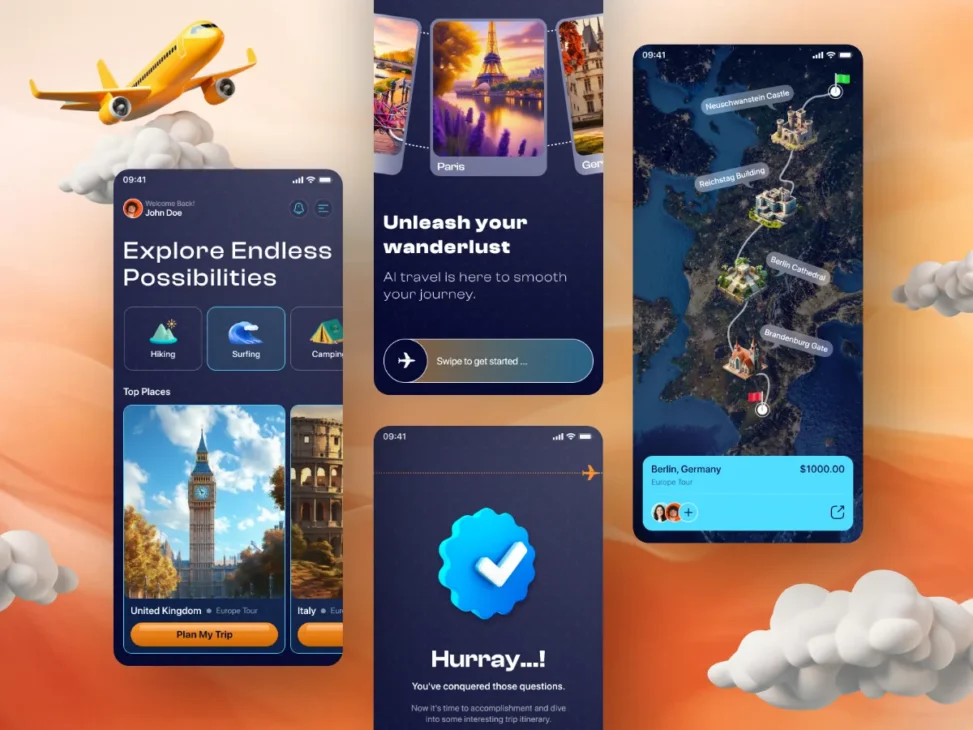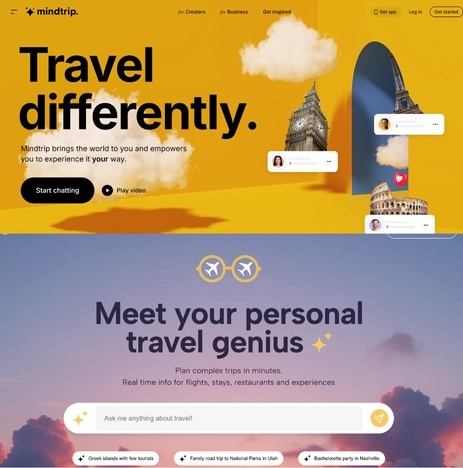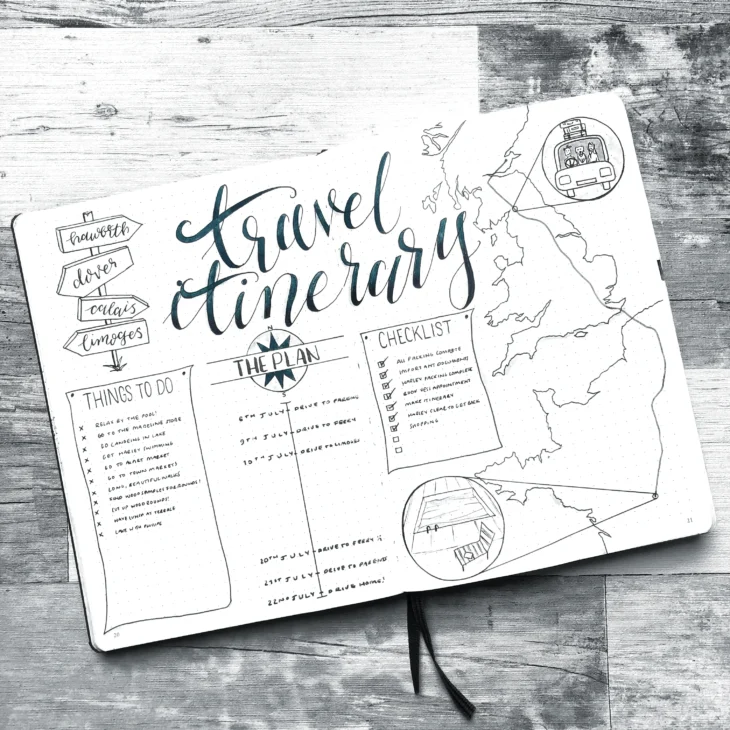AI vs Human: Who Plans a Better Trip?

Disclaimer: This article is not sponsored or affiliated with any of the tools, platforms, or services mentioned. All references are provided solely for informational and educational purposes. We do not receive any payment or commission for including them.
Picture this: It’s Friday morning. You’ve decided to escape to a vibrant seaside city with warm breezes, local street food, and easy rhythms. But here’s the twist: instead of juggling spreadsheets and 50 tabs of travel blogs, you turn to AI trip planning. You type in your dates, budget, and vibe-keywords like “relaxed, beach, local culture,” and within minutes, you have a full itinerary.
Could it really be that easy? And more importantly, can AI trip planning match what a human planner or your own travel instincts could create?
I love travelling, and I’m always wondering how much of the planning brain-work can be handed over. So, I set myself a challenge: I’m going to plan a short weekend getaway to Dar es Salaam, Tanzania, for two nights and three days, using two approaches side by side: one my own human-crafted itinerary (drawing on my usual traveller’s instinct) and one generated by an AI vacation planner. Then we’re going to see who comes out ahead.
The goal? To help you, the curious traveller, understand how AI trip planning stacks up and decide what kind of planner you’d trust for your next getaway.
Setting Up the Face-Off: AI vs Human Itinerary
Before diving into results, let’s break down how each side approaches trip planning. Understanding their methods will help make sense of where AI shines and where human intuition still leads.
Human-itinerary approach
When planning a trip, the “traditional” way, I start by asking: What kind of experience do I want? What pace? What culture? Then I dig into blogs, local tourism pages, travel forums, map out arrival/transfer times, factor in rest, find local-favorite restaurants, and seek out off-beat spots.
For Dar es Salaam, that would mean: an afternoon arrival, easy beach stroll, local seafood dinner, waking up early for a cultural neighborhood visit before heading to the ferry to an island, maybe squeezing in a wellness spa. I build hour by hour, but leave breathing space for spontaneity, because that’s where travel magic happens.
Pros: Deep research, local nuance, flexibility, emotional connection.
Cons: Time-consuming, prone to bias (you only find what you already know), and sometimes overwhelming.

The AI-Generated Itinerary
AI trip planners are like travel genies. You type your wishes “two nights in Dar es Salaam, beach vibes, local experiences” and within minutes, an itinerary appears. Mine looked something like this:
- Day 1: Check-in, sunset dinner at Cape Town Fish Market, visit The Slipway.
- Day 2: Morning ferry to Bongoyo Island, seafood lunch, return, and visit the Village Museum.
- Day 3: Brunch, quick art tour, airport transfer.
Efficient, yes. But it also skipped nuances like driving distances, closing times, and even suggested two activities that overlapped in time. AI didn’t know that Friday traffic in Dar es Salaam is notoriously unpredictable, or that the Village Museum closes earlier than most expect.
Understanding the AI Travel Planning Boom
Before judging who planned better, it helps to understand what’s powering the AI side of this experiment. The rise of machine learning and predictive algorithms has quietly transformed how we dream, plan, and book our trips.
The Tech Behind the Trend
AI travel tools have evolved beyond simple booking engines. Using machine learning, natural language processing (NLP), and predictive analytics, they can now understand your intent (“relaxed beach trip”), analyze your travel history, and generate personalized itineraries in seconds.
Through these algorithms, AI continuously learns from travelers’ choices, refining recommendations for hotels, flights, and experiences. The result? Instant, tailored suggestions with fewer booking errors and less guesswork.
Yet, AI struggles where human emotion and intuition come in: logical flow, storytelling, and unplanned serendipity.

The 2025 Landscape: Top 10 AI Trip Planners (and When to Use Them)
Before comparing results, I tested what’s out there. Here are the 10 most talked-about AI travel planners of 2025, and when to use them:
TripIt
Best for: Business travelers or anyone juggling flights, meetings, and hotels.
Pros: Automatically scans your emails for reservations and builds one neat master plan. Offers flight alerts, weather updates, and collaborative sharing.
Cons: Leans on email forwarding; advanced AI perks are locked behind a paywall.
Pricing: Free core features, Pro plan $49/year (with a 30-day trial).
Why it matters: If you’re a frequent traveler, TripIt is like your personal travel secretary who never forgets a booking confirmation.
Layla
Best for: Romantic getaways or personalized weekend escapes.
Pros: Feels like chatting with a travel-savvy friend. Generates mood boards and thoughtful local ideas (like hidden rooftop cafés).
Cons: Too many suggestions if you don’t narrow your prompts; strongest for English-speaking countries.
Pricing: 100% free.
Wanderlog
Best for: Road trips or multi-city adventures.
Pros: Map-based itinerary builder, group editing, and offline mode.
Cons: Interface can feel crowded; some AI tools need a Pro plan.
Pricing: Free plan for basics; Pro ~$39/year.
Real talk: If your travel style includes “let’s take a detour,” Wanderlog is your digital map companion.
Mindtrip
Best for: Luxury travelers and experience seekers.
Pros: Gorgeous VR previews, curated recommendations, and dynamic learning from previous trips.
Cons: Expensive taste; may not suit budget travelers.
Pricing: Free core tools; premium tier in development.
Good to know: Its visual itineraries are stunning, ideal if aesthetics matter to your travel planning.
TripAdvisor’s AI Trip Builder
Best for: Families and budget-conscious travelers.
Pros: Uses millions of reviews to filter the best options. Free and easy to tweak.
Cons: Skews toward touristy spots; ad-heavy interface.
Pricing: Entirely free.
Reality check: Reliable, yes, but don’t expect many hidden gems.
GuideGeek
Best for: Adventure travelers and cultural deep-divers.
Pros: Chat via WhatsApp, focus on local ethics and sustainability.
Cons: No visuals; sometimes brief replies.
Pricing: Totally free (funded by tourism partnerships).
Best use: “Message it mid-trip to find a last-minute snorkeling guide near Oyster Bay.”

Vacay Chatbot
Best for: Solo travelers or digital nomads.
Pros: Combines remote-work info with travel plans; smart about visas and Wi-Fi spots.
Cons: Can lag under high demand; accuracy varies in less-traveled areas.
Pricing: Free tier (5 chats/day); Premium $9.99/month.
Traveler tip: Great for long-term travelers balancing work and leisure.
Plantrip
Best for: Travelers who want fast, AI-curated itineraries that balance spontaneity and structure.
Pros: Creates complete, day-by-day plans in seconds; syncs with Google Maps for directions and nearby attractions; great for quick weekend getaways.
Cons: Sometimes overlooks driving distances or opening hours; not ideal for multi-city or highly customized trips.
Pricing: Free for basic planning; premium plan (~$10/month) adds personalized recommendations, offline mode, and priority support.
Fun fact: Tell it you’ve got “three days, a small budget, and big wanderlust,” and it’ll still build you a surprisingly solid itinerary.
Copilot2Trip
Best for: Eco-travelers and wellness-focused journeys.
Pros: Prioritizes sustainable routes, offers mindfulness-based trip suggestions.
Cons: Narrow niche; app-only.
Pricing: Free for basic AI planning; pro plans (~$99/month) for advanced users.
Fun fact: It’ll recommend a yoga retreat over a nightclub, and mean it.
ChatGPT (Travel Mode)
Best for: Creative explorers who love brainstorming flexible trip ideas through conversation.
Pros: Naturally conversational, adaptable to any travel style, and can plan around your tone or mood; great for “what-if” trip scenarios.
Cons: Doesn’t display live pricing or integrate with booking sites.
Pricing: Free with ChatGPT; best experience on the Plus plan ($20/month).
Fun fact: It’s like having a witty travel buddy who never gets tired of your “what if we went there instead?” ideas.
AI planners come in flavors: fast, creative, detailed, or aesthetic. Mix and match to find your sweet spot. Personally, I found Layla’s tone warm and Wanderlog’s maps useful for fine-tuning. There are also others like Wonderplan.ai, which are beginner-friendly.
The Tanzania Weekend Test: My Dual Itinerary Experiment
With all the tools explored, it’s time to see how they actually perform. To put AI planning to the test, I ran a real-world experiment using a weekend trip to Tanzania as the ultimate case study.
How AI Planned My Dar es Salaam Getaway
AI delivered an itinerary that looked perfect at first glance: clean, time-boxed, and hyper-efficient. It even suggested specific restaurants with links. But when I dug deeper, I noticed cracks:
- It ignored local traffic realities (Dar rush hour is no joke).
- It didn’t consider opening/closing times.
- It lacked logical flow (a back-and-forth between far-flung spots).
Still, I appreciated how it balanced budget and experience, recommending a stay at an affordable beachfront Airbnb near Oyster Bay.
My Human-Designed Plan
Mine took longer, about three hours, but it told a story. I started with a Friday night seafood dinner, followed by a lazy Saturday island escape, and a Sunday morning art stroll before heading home. It flowed naturally, leaving space for spontaneity, like chatting with locals or grabbing fresh coconut juice by the beach.

Comparing Both: The Real Face-Off
| Criteria | AI Itinerary | Human Itinerary |
|---|---|---|
| Speed | Instant | 3+ hours |
| Accuracy | Missed closing hours, traffic | Context-aware |
| Creativity | Predictable spots | Off-beat gems |
| Cost-efficiency | Balanced | Flexible |
| Emotional connection | None | Strong |
| Crisis handling | Weak | Adaptive |
Verdict: AI gave me a solid template; I gave it a soul.
Strengths and Shortcomings
With both itineraries laid out, clear patterns began to emerge. Each planner, AI, and human brought its own strengths to the table, along with a few unavoidable weaknesses.
Comparative Advantages of AI Trip Planners
- Speed & Efficiency: Generates plans in seconds.
- Cost-Effective: No service fees or commissions.
- Personalization: Learns your preferences over time.
- Data Power: Real-time info on flights, weather, and prices.
Where Humans Still Win
- Intuition & Emotion: We can read moods and weather vibes.
- Crisis Management: We pivot fast during flight delays or emergencies.
- Cultural Sensitivity: Humans understand nuance, etiquette, and local quirks.
- Creativity: Only a human can suggest “skip the museum, join a local cooking class instead.”
The Future Is Hybrid: Where AI Meets Human Touch
The next evolution in travel planning combines AI trip planning with human intuition. Start with an AI vacation planner to draft routes, estimate costs, suggest hotels, and organize flights in minutes. This gives you a solid, data-driven structure that saves time and reduces errors while covering all the logistics.
Then, layer in your own instincts: adjust timings, add hidden gems, or create moments that make the trip memorable. Humans bring creativity, emotional depth, and flexibility that AI can’t replicate. Together, this hybrid approach delivers itineraries that are efficient, practical, and personalized, balancing smart automation with meaningful travel experiences.
Because ultimately, travel isn’t just about logistics, it’s about emotion.

Who Would I Trust With My Next Getaway?
If travel is about ticking boxes, AI wins hands down. But if travel is about stories, serendipity, and soul, humans still lead.
For my Tanzania trip, AI helped me organize, but my human instincts made it unforgettable. The future isn’t AI versus humans. It’s AI plus humans: structured efficiency meeting emotional intelligence.
So next time you plan a getaway, let AI set the foundation, but don’t forget to bring your human compass. That’s where the adventure begins.
FAQs
Is AI travel planning reliable?
AI travel planners are reliable for popular destinations and short trips, using large databases and real-time updates to find flights, hotels, and attractions quickly. They perform best in well-documented cities like Paris or Tokyo. For smaller or emerging destinations, like lesser-known towns in Tanzania, AI may miss local insights or rely on outdated data. In short, AI is great for structured planning but can’t replace human intuition and cultural knowledge.
Can AI replace human travel agents?
Not quite, at least, not yet. AI can plan efficiently, but it lacks the empathy and creativity that human travel agents offer. Humans understand emotional cues, like needing a “quiet escape” after burnout, while AI only interprets data. The best approach? Use AI for convenience and humans for connection and meaningful experiences.
What about data privacy when using AI travel planners?
AI travel planners collect basic details like your name, email, travel history, and location data. Reputable ones follow privacy laws such as the GDPR (General Data Protection Regulation) and encrypt your information, but it’s wise to read their terms carefully. Some may share anonymized data for analytics or marketing. To stay safe, use trusted tools, avoid uploading sensitive files, and always log out of shared devices. Think of it as good digital travel hygiene.
When should I not use an AI planner?
AI excels at organizing and optimizing trips, but it’s not perfect for every scenario. Highly emotional, complex, or culturally nuanced travel, like honeymoons, family reunions, or spiritual journeys, still needs a human touch. AI also struggles with multi-city or rural itineraries where local knowledge matters. Combining AI’s efficiency with human insight ensures a trip that’s both organized and authentic.


